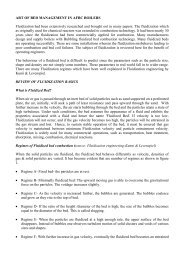Create successful ePaper yourself
Turn your PDF publications into a flip-book with our unique Google optimized e-Paper software.
The theory<br />
As long as the fluid speed is sufficiently<br />
subsonic (V < mach 0.3), the<br />
<strong>in</strong>compressible Bernoulli's equ<strong>at</strong>ion (<br />
equ<strong>at</strong>ion 1) describes the flow. Apply<strong>in</strong>g<br />
Bernoulli equ<strong>at</strong>ion to air stream<br />
travell<strong>in</strong>g down the axis of the horizontal<br />
tube gives the equ<strong>at</strong>ion 2 & 3.<br />
2<br />
Va<br />
<br />
Pa<br />
gZ<br />
2<br />
2<br />
a<br />
P<br />
2<br />
b<br />
2<br />
Vb<br />
<br />
gZ<br />
2<br />
Va<br />
Vb<br />
<br />
Pa<br />
Pb<br />
( equ<strong>at</strong>ion<br />
2)<br />
2 2<br />
P<br />
P<br />
P<br />
Q <br />
<br />
a<br />
1<br />
2<br />
P<br />
b<br />
V<br />
2P<br />
<br />
Q C *<br />
2<br />
2<br />
Vb<br />
Va<br />
<br />
( equ<strong>at</strong>ion<br />
3)<br />
2 2<br />
2<br />
a<br />
<br />
A<br />
<br />
<br />
<br />
A<br />
a<br />
b<br />
<br />
<br />
<br />
2<br />
Aa<br />
<br />
A <br />
a<br />
<br />
<br />
<br />
<br />
Ab<br />
<br />
2 * P<br />
<br />
2<br />
<br />
1(<br />
equ<strong>at</strong>ion<br />
<br />
( equ<strong>at</strong>ion<br />
<br />
1<br />
<br />
Aa<br />
<br />
A <br />
a<br />
<br />
<br />
<br />
<br />
Ab<br />
<br />
2<br />
b<br />
( equ<strong>at</strong>ion1)<br />
4)<br />
5)<br />
( equ<strong>at</strong>ion<br />
<br />
1<br />
<br />
6)<br />
From cont<strong>in</strong>uity, the thro<strong>at</strong> velocity V b<br />
can be substituted out of the above<br />
equ<strong>at</strong>ion to give, Solv<strong>in</strong>g for the<br />
upstream velocity V a and multiply<strong>in</strong>g by<br />
the cross-sectional area A a gives the<br />
volumetric flow r<strong>at</strong>e Q,<br />
Ideal, non-viscous fluids would obey the<br />
above equ<strong>at</strong>ion. The small amounts of<br />
energy converted <strong>in</strong>to he<strong>at</strong> with<strong>in</strong><br />
viscous boundary layers tend to lower<br />
the actual velocity of real fluids<br />
somewh<strong>at</strong>. A discharge coefficient C is<br />
typically <strong>in</strong>troduced to account for the<br />
viscosity of fluids, C is found to depend<br />
on the Reynolds Number of the flow,<br />
and usually lies between 0.90 and 0.98<br />
for smoothly taper<strong>in</strong>g venturis.<br />
Higher PA header pressure results <strong>in</strong><br />
<strong>in</strong>creased pressure drop (ΔP) and thus<br />
the Q <strong>in</strong>creases. If PA header pressure is<br />
<strong>in</strong>creased and as the downstream<br />
pressure is fairly constant due to<br />
fluidized bed back pressure, the suction<br />
<strong>at</strong> thro<strong>at</strong> improves.<br />
Calcul<strong>at</strong>ion & <strong>in</strong>ference<br />
1. Us<strong>in</strong>g Bernoulli pr<strong>in</strong>ciple, we calcul<strong>at</strong>ed th<strong>at</strong> the l<strong>in</strong>e velocity to be as high as 24 m/s. Even then<br />
the suction was not enough. It meant the energy was not used up <strong>in</strong> cre<strong>at</strong><strong>in</strong>g good suction <strong>at</strong><br />
venturi.<br />
2. It was also seen th<strong>at</strong> the PA l<strong>in</strong>es were currently oper<strong>at</strong><strong>in</strong>g on high l<strong>in</strong>e velocities. The erosion<br />
seen <strong>in</strong> bed coils confirmed this. The erosion r<strong>at</strong>e was more where the coils were close the fuel<br />
nozzle cap.<br />
3. Two mix<strong>in</strong>g nozzles were dismantled & seen. The thro<strong>at</strong> diameters were measured to be 50 & 48<br />
mm. We recommended th<strong>at</strong> the mix<strong>in</strong>g nozzle is replaced with 42 mm thro<strong>at</strong> mix<strong>in</strong>g nozzles so<br />
th<strong>at</strong> the air flow is reduced simultaneously improv<strong>in</strong>g the suction.


















